Rotating Instabilities in a Low-Speed Single Compressor Rotor Row with Varying Blade Tip Clearance
Abstract
:1. Introduction
2. Experimental Setup
3. Numerical and Mathematical Approaches
3.1. Mesh Setup
3.2. Numerical Setup
3.3. DMD Method
4. Results and Discussion
4.1. Overall Performance
4.2. Dynamic Characteristics
4.3. DMD-Based Analysis
5. Conclusions
Author Contributions
Funding
Acknowledgments
Conflicts of Interest
Abbreviations
| BPF | Blade passing frequency |
| CFD | Computational fluid dynamics |
| DMD | Dynamic mode decomposition |
| FFT | Fast Fourier transform |
| LE | Leading edge |
| LSRC | Low speed research compressor |
| NSV | Non-synchronous vibration |
| PSD | Power spectral density |
| RANS | Reynolds-averaged Navier–Stokes |
| RI | Rotating instability |
| SST | Shear stress transport |
| STD | Standard deviation |
| TE | Trailing edge |
| TLV | Tip leakage vortex |
| ZLES | Zonal large eddy simulation |
References
- Day, I.J. Stall, Surge, and 75 Years of Research. J. Turbomach. 2015, 138, 011001. [Google Scholar] [CrossRef]
- Mailach, R.; Lehmann, I.; Vogeler, K. Rotating Instabilities in an Axial Compressor Originating from the Fluctuating Blade Tip Vortex. J. Turbomach. 2000, 123, 453–460. [Google Scholar] [CrossRef]
- Mathioudakis, K.; Breugelmans, F.A.E. Development of Small Rotating Stall in a Single Stage Axial Compressor. In Volume 1: Aircraft Engine; Marine; Turbomachinery; Microturbines and Small Turbomachinery; V001T03A064; Turbo Expo: Power for Land, Sea, and Air; American Society of Mechanical Engineers: New York, NY, USA, 1985. [Google Scholar] [CrossRef] [Green Version]
- Liu, J.; Holste, F.; Neise, W. On the azimuthal mode structure of rotating blade flow instabilities in axial turbomachines. In Proceedings of the Aeroacoustics Conference, State College, PA, USA, 6–8 May 1996; American Institute of Aeronautics and Astronautics: Reston, VA, USA, 1996. [Google Scholar] [CrossRef]
- Kameier, F.; Neise, W. Experimental Study of Tip Clearance Losses and Noise in Axial Turbomachines and Their Reduction. J. Turbomach. 1997, 119, 460–471. [Google Scholar] [CrossRef]
- Mailach, R.; Sauer, H.; Vogeler, K. The Periodical Interaction of the Tip Clearance Flow in the Blade Rows of Axial Compressors. In Volume 1: Aircraft Engine; Marine; Turbomachinery; Microturbines and Small Turbomachinery; American Society of Mechanical Engineers: New York, NY, USA, 2001. [Google Scholar] [CrossRef]
- Rolfes, M.; Lange, M.; Mailach, R. Investigation of Performance and Rotor Tip Flow Field in a Low Speed Research Compressor with Circumferential Groove Casing Treatment at Varying Tip Clearance. Int. J. Rotating Mach. 2017, 2017, 4631751. [Google Scholar] [CrossRef] [Green Version]
- Beselt, C.; van Rennings, R.; Sorge, R.; Peitsch, D.; Thiele, F.; Ehrenfried, K.; Thamsen, P.U.; Pardowitz, B.; Enghardt, L. Influence of the clearance size on rotating instability in an axial compressor stator. In Proceedings of the 10th European Conference on Turbomachinery Fluid dynamics & Thermodynamics, Lappeenranta, Finland, 15–19 April 2013; European Turbomachinery Society: Florence, Italy, 2013. [Google Scholar]
- Wu, Y.; Wu, J.; Zhang, G.; Chu, W. Experimental and Numerical Investigation of Flow Characteristics Near Casing in an Axial Flow Compressor Rotor at Stable and Stall Inception Conditions. J. Fluids Eng. 2014, 136, 111106. [Google Scholar] [CrossRef]
- Yang, W.; Wang, Y.; Han, L.; Zhang, X.; Li, Z. Effect of Rotating Instabilities on Aerodynamic Damping of Axial Flow Fan Blades. In Volume 7A: Structures and Dynamics; American Society of Mechanical Engineers: New York, NY, USA, 2019. [Google Scholar] [CrossRef]
- Biela, C.; Müller, M.W.; Schiffer, H.P.; Zscherp, C. Unsteady Pressure Measurement in a Single Stage Axial Transonic Compressor near the Stability Limit. In Volume 6: Turbomachinery, Parts A, B, and C; American Society of Mechanical Engineers: New York, NY, USA, 2008. [Google Scholar] [CrossRef]
- Hah, C.; Bergner, J.; Schiffer, H.P. Tip Clearance Vortex Oscillation, Vortex Shedding and Rotating Instabilities in an Axial Transonic Compressor Rotor. In Volume 6: Turbomachinery, Parts A, B, and C; American Society of Mechanical Engineers: New York, NY, USA, 2008. [Google Scholar] [CrossRef]
- Sun, Z.; Zou, W.; Zheng, X. Instability detection of centrifugal compressors by means of acoustic measurements. Aerosp. Sci. Technol. 2018, 82–83, 628–635. [Google Scholar] [CrossRef]
- He, X.; Zheng, X. Roles and mechanisms of casing treatment on different scales of flow instability in high pressure ratio centrifugal compressors. Aerosp. Sci. Technol. 2019, 84, 734–746. [Google Scholar] [CrossRef]
- Zhang, L.Y.; He, L.; Stüer, H. A Numerical Investigation of Rotating Instability in Steam Turbine Last Stage. J. Turbomach. 2012, 135, 011009. [Google Scholar] [CrossRef]
- Gerschütz, W.; Casey, M.; Truckenmüller, F. Experimental investigations of rotating flow instabilities in the last stage of a low-pressure model steam turbine during windage. Proc. Inst. Mech. Eng. Part A J. Power Energy 2005, 219, 499–510. [Google Scholar] [CrossRef]
- Hoying, D.A.; Tan, C.S.; Vo, H.D.; Greitzer, E.M. Role of Blade Passage Flow Structurs in Axial Compressor Rotating Stall Inception. J. Turbomach. 1999, 121, 735–742. [Google Scholar] [CrossRef]
- Vo, H.D. Role of Tip Clearance Flow in Rotating Instabilities and Nonsynchronous Vibrations. J. Propuls. Power 2010, 26, 556–561. [Google Scholar] [CrossRef]
- März, J.; Hah, C.; Neise, W. An Experimental and Numerical Investigation into the Mechanisms of Rotating Instability. J. Turbomach. 2002, 124, 367–374. [Google Scholar] [CrossRef]
- Kielb, R.E.; Barter, J.W.; Thomas, J.P.; Hall, K.C. Blade Excitation by Aerodynamic Instabilities: A Compressor Blade Study. In Proceedings of the Turbo Expo 2003, Atlanta, GA, USA, 16–19 June 2003; American Society of Mechanical Engineers: New York, NY, USA, 2003; Volume 4. [Google Scholar] [CrossRef] [Green Version]
- Pardowitz, B.; Tapken, U.; Enghardt, L. Time-resolved Rotating Instability Waves in an annular Cascade. In Proceedings of the 18th AIAA/CEAS Aeroacoustics Conference (33rd AIAA Aeroacoustics Conference), Colorado Springs, CO, USA, 4–6 June 2012; American Institute of Aeronautics and Astronautics: Reston, VA, USA, 2012. [Google Scholar] [CrossRef]
- Pardowitz, B.; Tapken, U.; Sorge, R.; Thamsen, P.U.; Enghardt, L. Rotating Instability in an Annular Cascade: Detailed Analysis of the Instationary Flow Phenomena. J. Turbomach. 2013, 136, 061017. [Google Scholar] [CrossRef]
- Pardowitz, B.; Moreau, A.; Tapken, U.; Enghardt, L. Experimental identification of rotating instability of an axial fan with shrouded rotor. Proc. Inst. Mech. Eng. Part A J. Power Energy 2015, 229, 520–528. [Google Scholar] [CrossRef]
- Wu, Y.; Chen, Z.; An, G.; Liu, J.; Yang, G. Origins and Structure of Rotating Instability: Part 1—Experimental and Numerical Observations in a Subsonic Axial Compressor Rotor. In Volume 2D: Turbomachinery; American Society of Mechanical Engineers: New York, NY, USA, 2016. [Google Scholar] [CrossRef]
- Geng, S.; Lin, F.; Chen, J.; Nie, C. Evolution of unsteady flow near rotor tip during stall inception. J. Therm. Sci. 2011, 20, 294–303. [Google Scholar] [CrossRef]
- Cravero, C.; Marsano, D. Criteria for the Stability Limit Prediction of High Speed Centrifugal Compressors with Vaneless Diffuser: Part I—Flow Structure Analysis. In Volume 2E: Turbomachinery; V02ET39A013; Turbo Expo: Power for Land, Sea, and Air; American Society of Mechanical Engineers: New York, NY, USA, 2020. [Google Scholar] [CrossRef]
- Eck, M.; Geist, S.; Peitsch, D. Physics of Prestall Propagating Disturbances in Axial Compressors and Their Potential as a Stall Warning Indicator. Appl. Sci. 2017, 7, 285. [Google Scholar] [CrossRef] [Green Version]
- Wang, H.; Wu, Y.; Wang, Y.; Deng, S. Evolution of the flow instabilities in an axial compressor rotor with large tip clearance: An experimental and URANS study. Aerosp. Sci. Technol. 2020, 96, 105557. [Google Scholar] [CrossRef]
- Chen, X.; Koppe, B.; Lange, M.; Chu, W.; Mailach, R. Comparison of Turbulence Modeling for a Compressor Rotor at Different Tip Clearances. AIAA J. 2021. [Google Scholar] [CrossRef]
- Boos, P.; Möckel, H.; Henne, J.M.; Selmeier, R. Flow Measurement in a Multistage Large Scale Low Speed Axial Flow Research Compressor. In Volume 1: Turbomachinery; American Society of Mechanical Engineers: New York, NY, USA, 1998. [Google Scholar] [CrossRef] [Green Version]
- ANSYS CFX. ANSYS CFX-Solver Theory Guide; ANSYS CFX Release 2020; ANSYS: Canonsburg, PA, USA, 2020. [Google Scholar]
- Menter, F.R. Best Practice: Scale-Resolving Simulations in ANSYS CFD; ANSYS Germany GmbH: Otterfing, Germany, 2012; Volume 1. [Google Scholar]
- Tu, J.H.; Rowley, C.W.; Luchtenburg, D.M.; Brunton, S.L.; Kutz, J.N. On dynamic mode decomposition: Theory and applications. J. Comput. Dyn. 2014, 1, 391–421. [Google Scholar] [CrossRef] [Green Version]
- Yamada, K.; Kikuta, H.; Iwakiri, K.I.; Furukawa, M.; Gunjishima, S. An Explanation for Flow Features of Spike-Type Stall Inception in an Axial Compressor Rotor. J. Turbomach. 2012, 135, 021023. [Google Scholar] [CrossRef]
- Pullan, G.; Young, A.M.; Day, I.J.; Greitzer, E.M.; Spakovszky, Z.S. Origins and Structure of Spike-Type Rotating Stall. J. Turbomach. 2015, 137, 051007. [Google Scholar] [CrossRef]
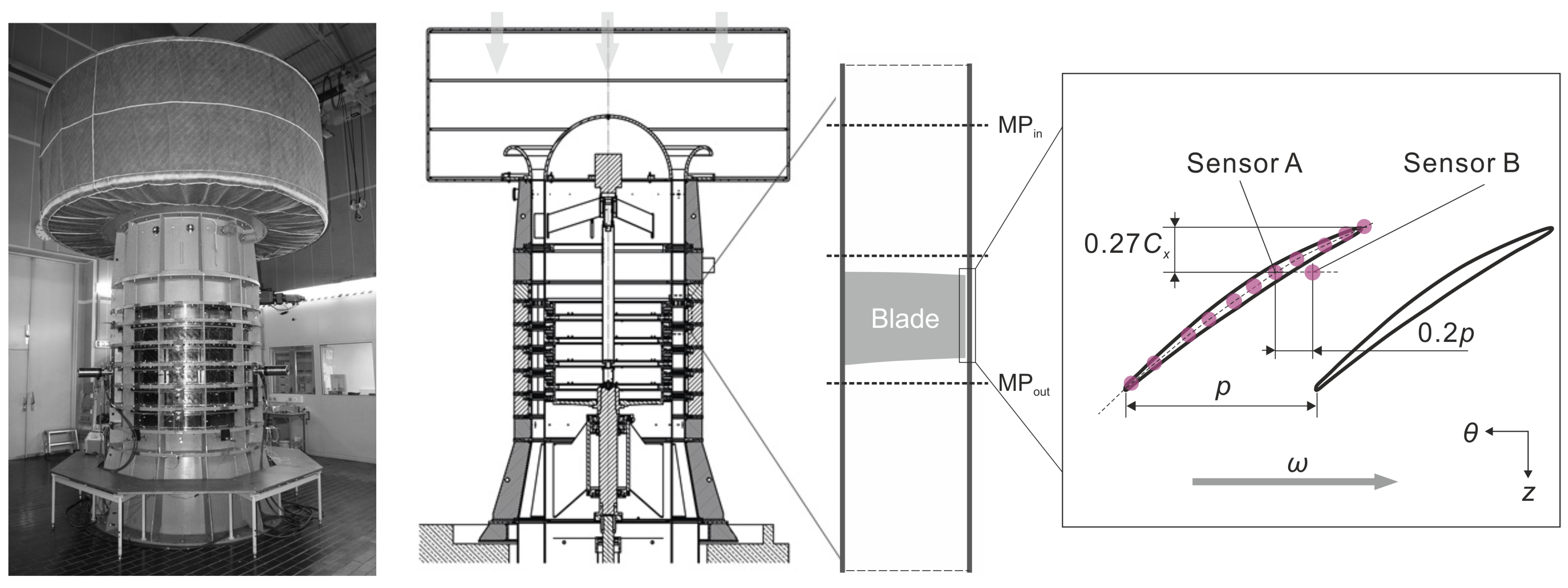
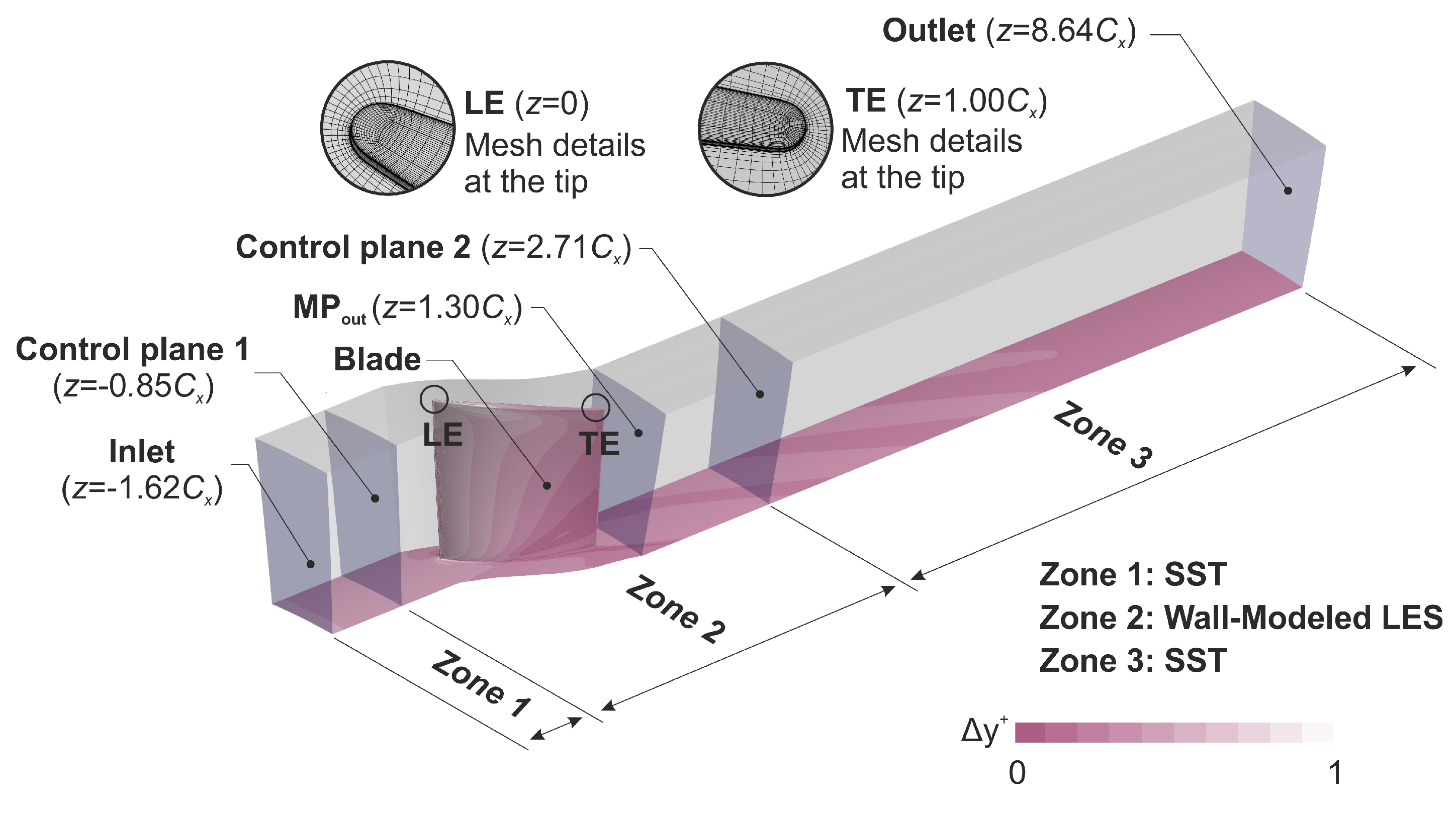
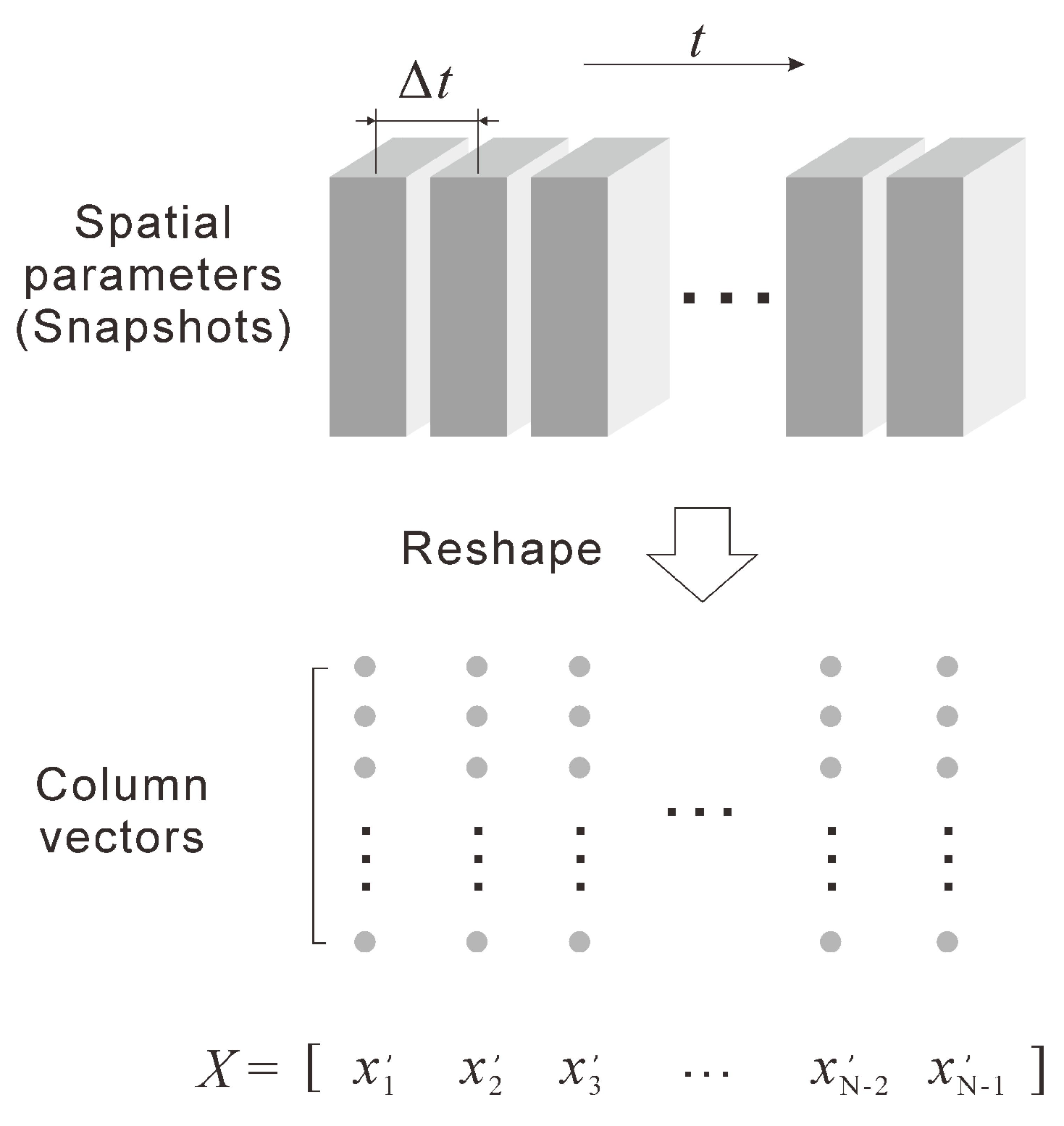
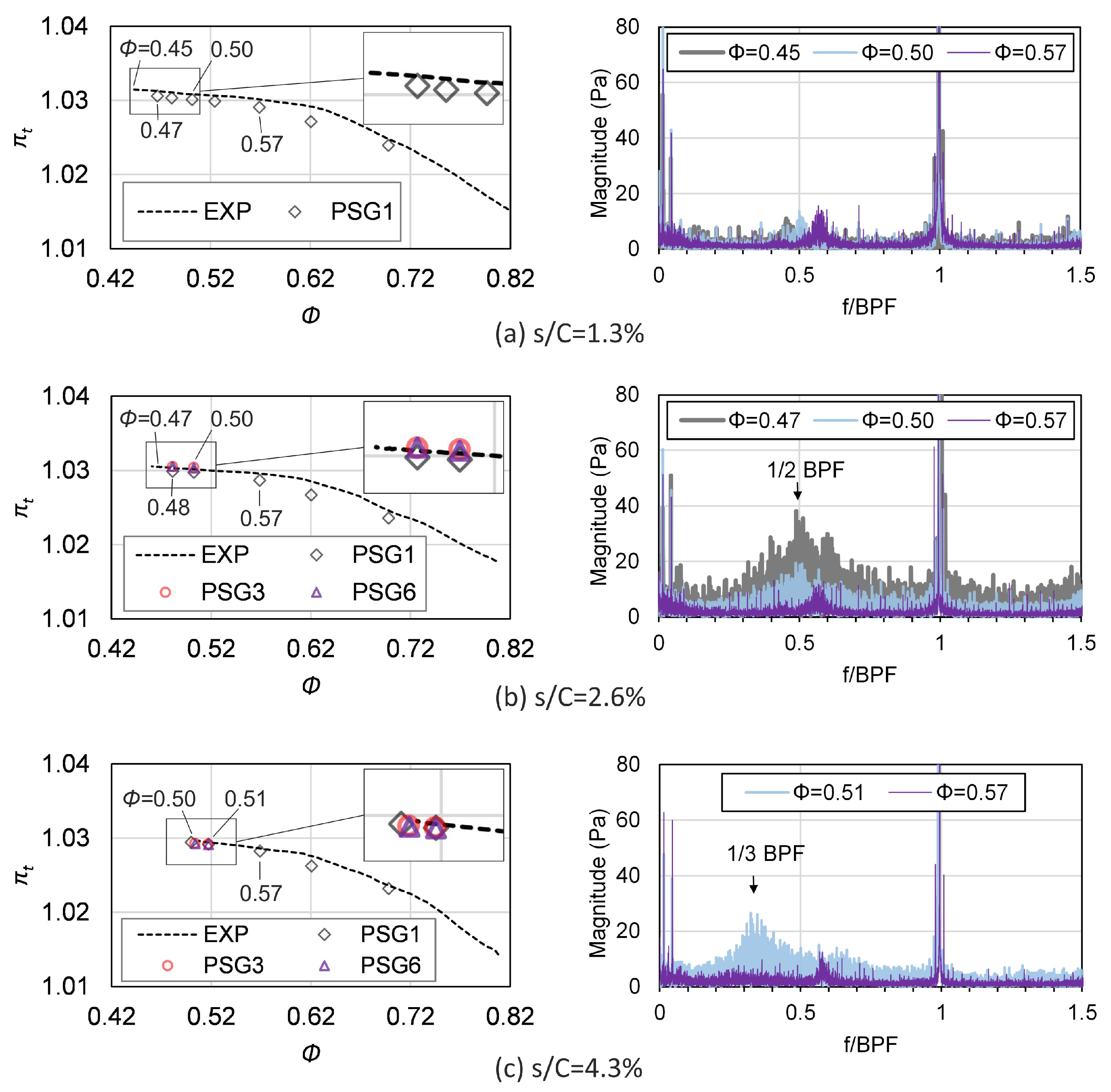

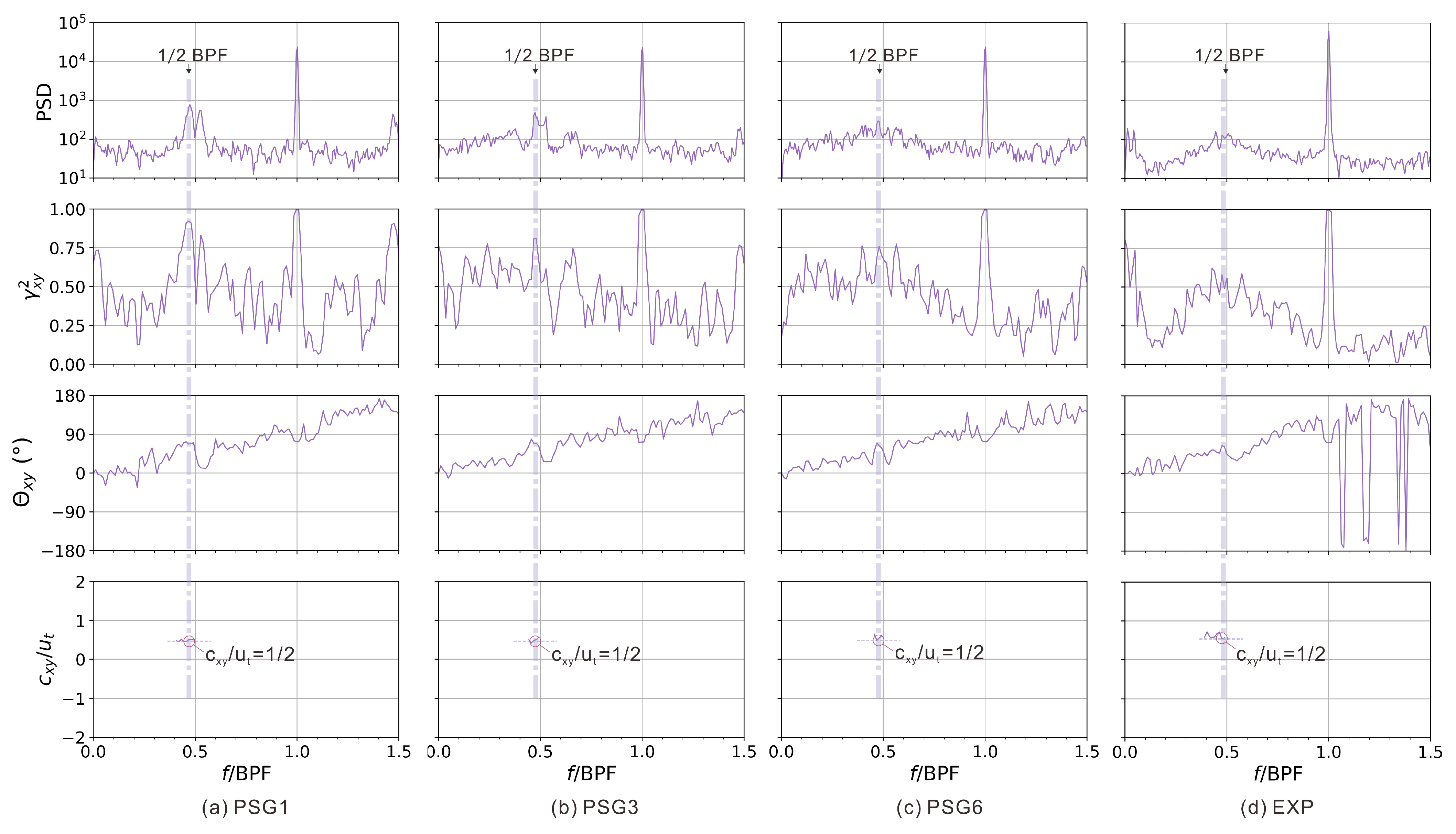

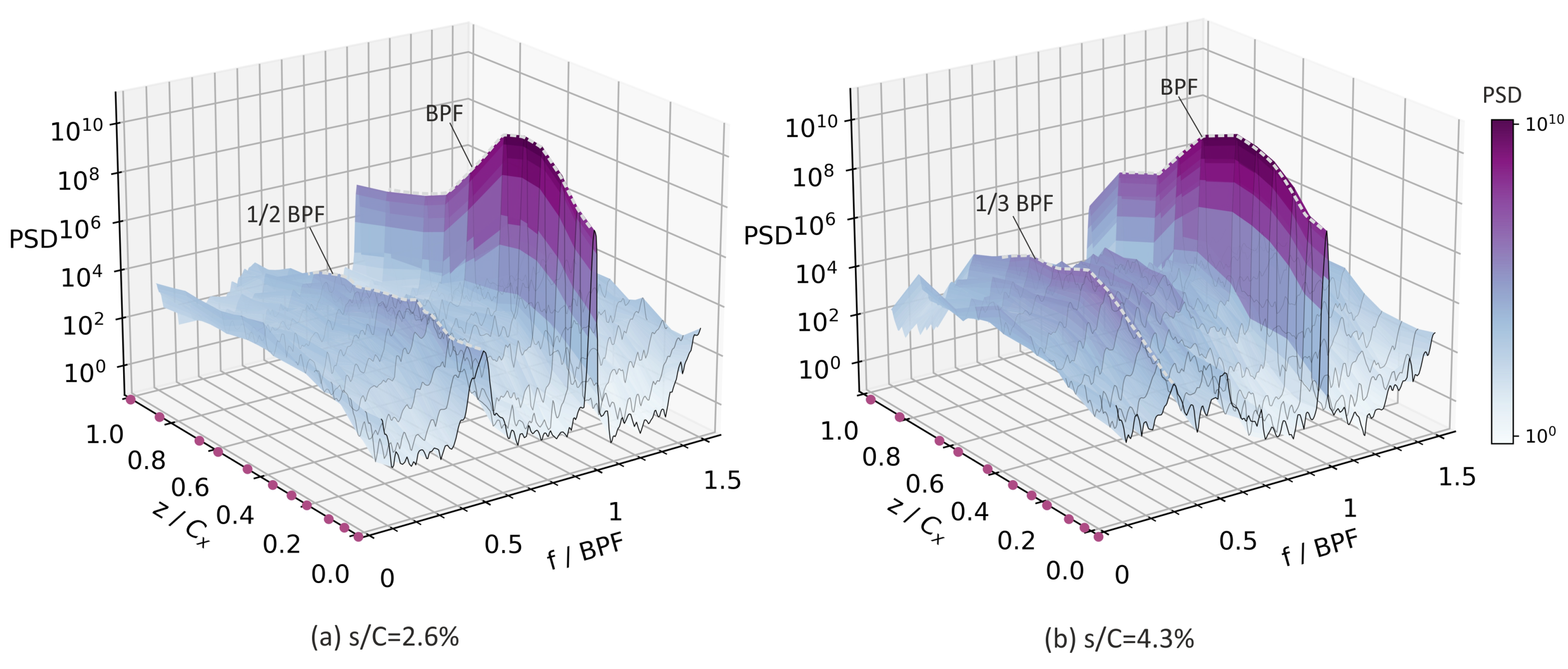
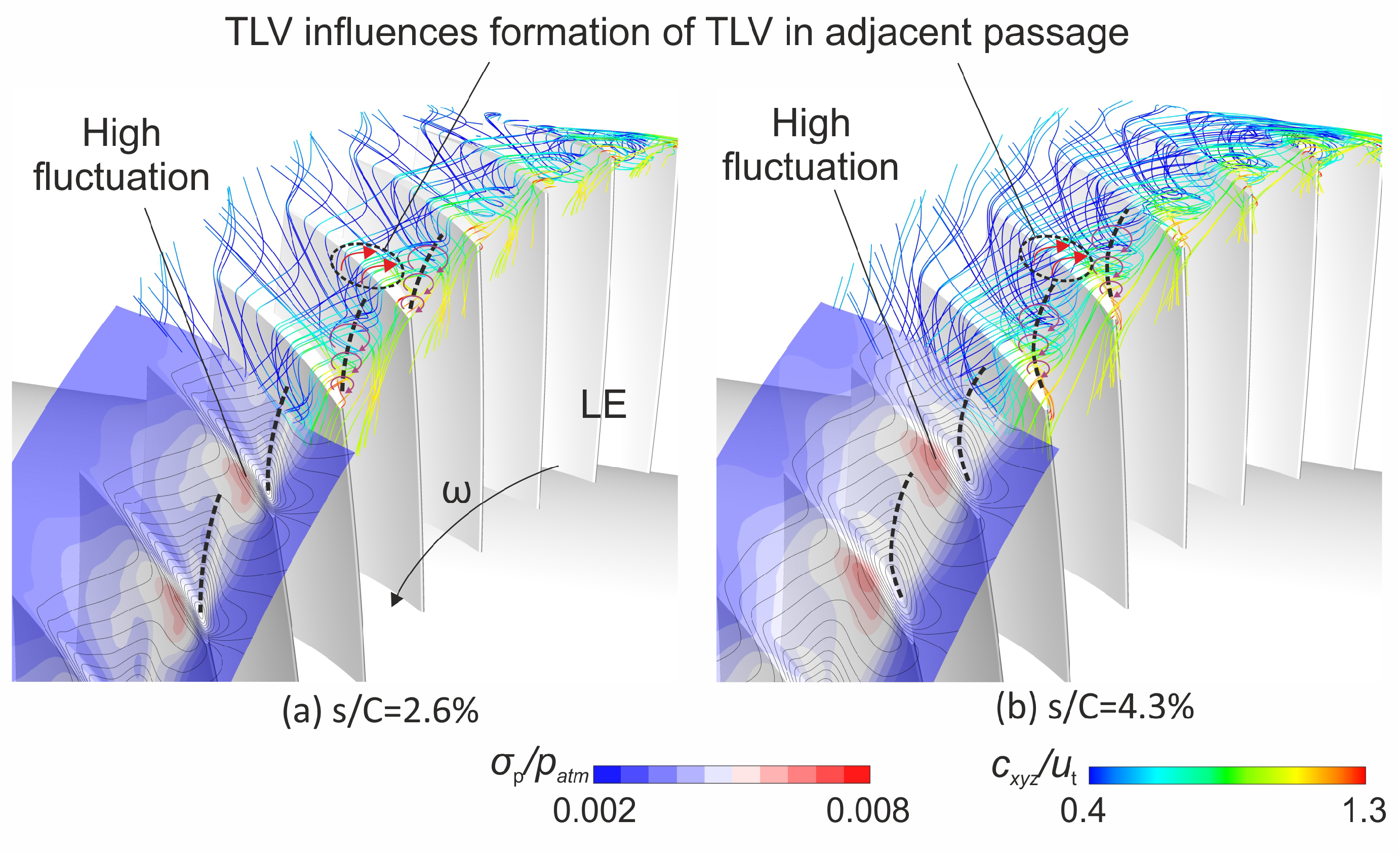
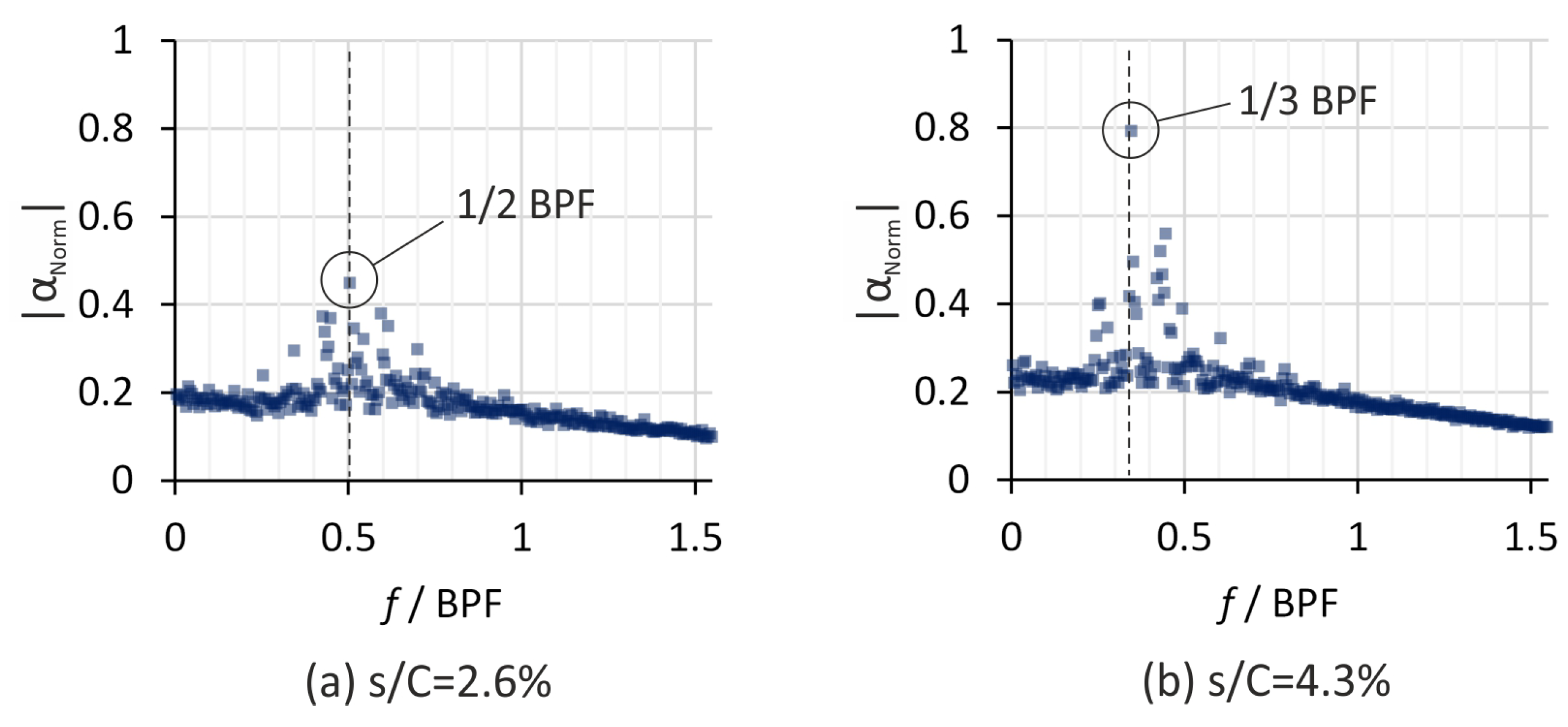
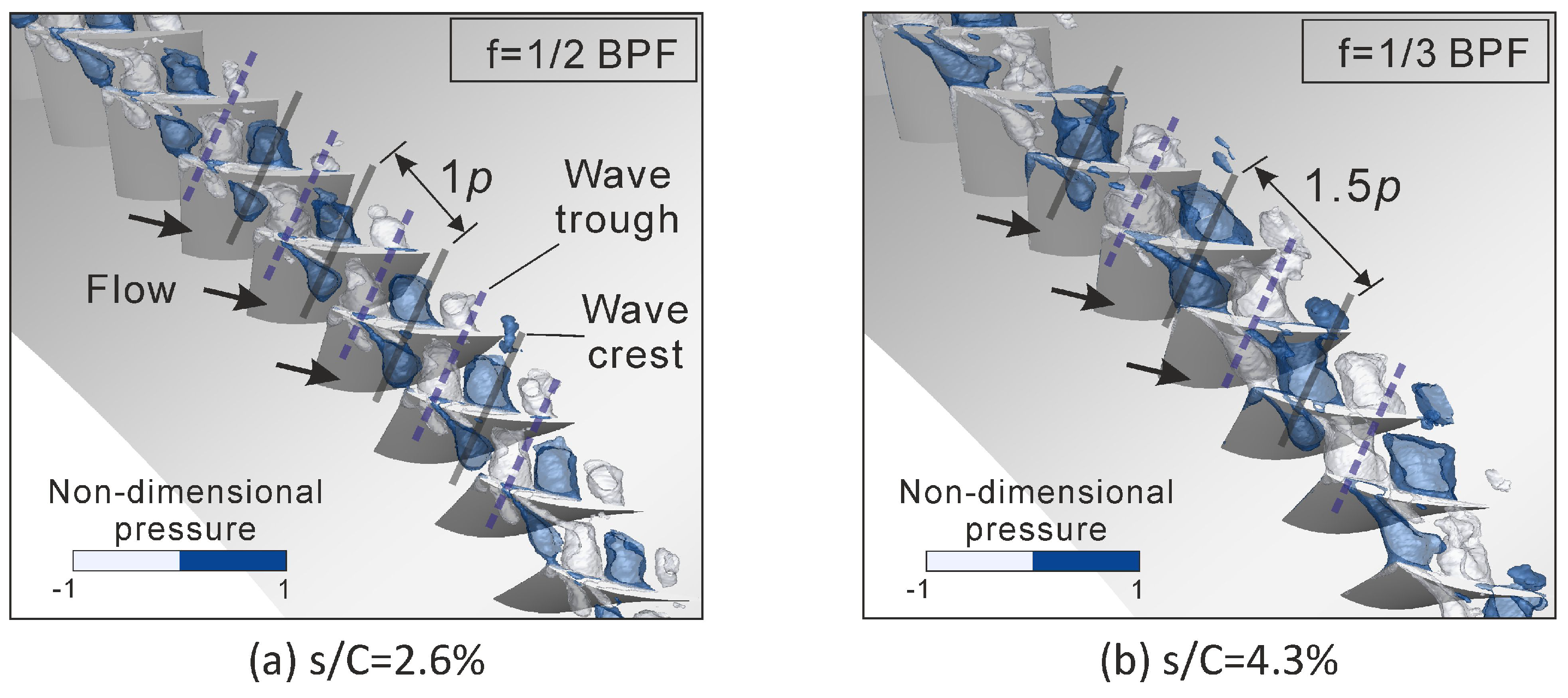
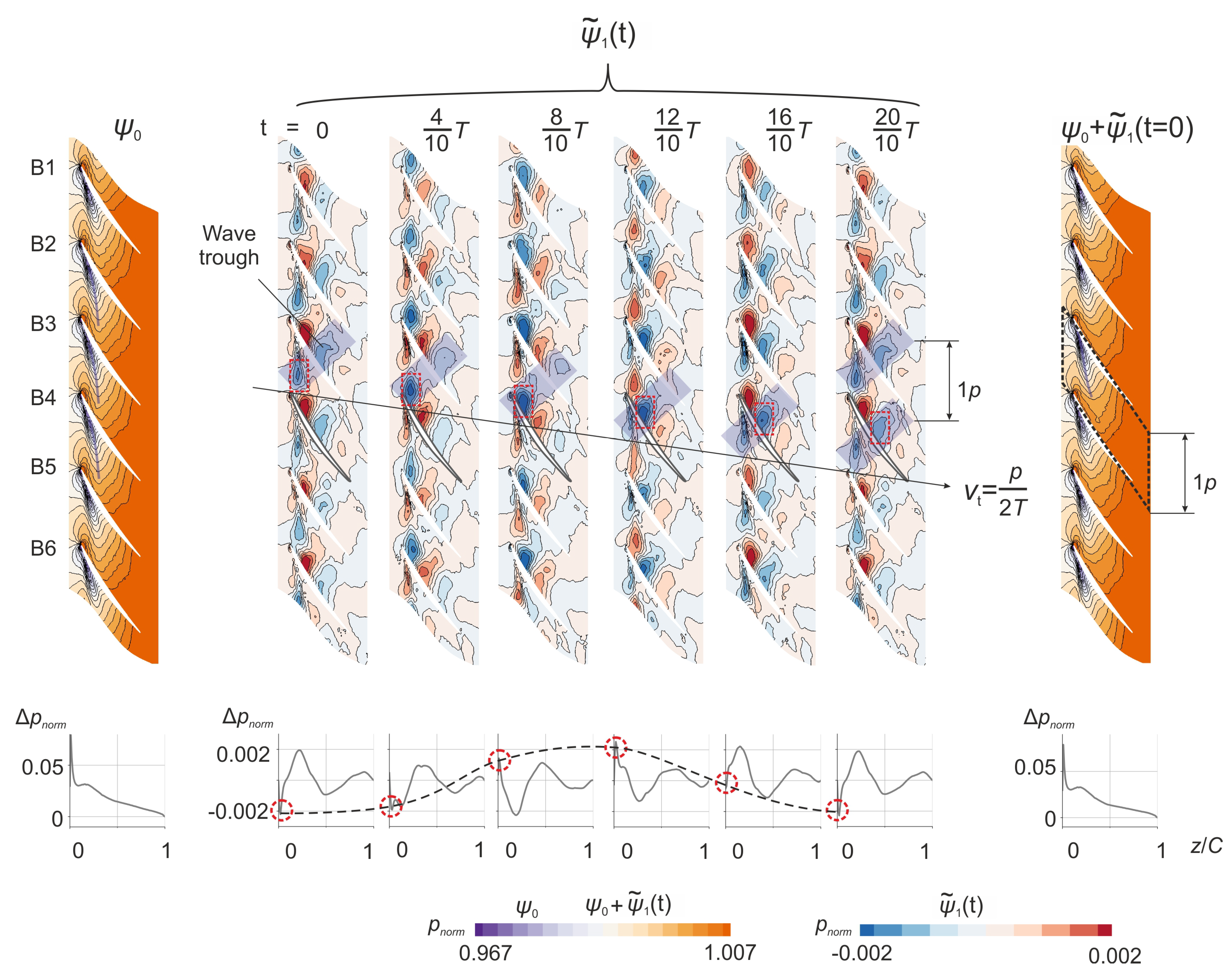
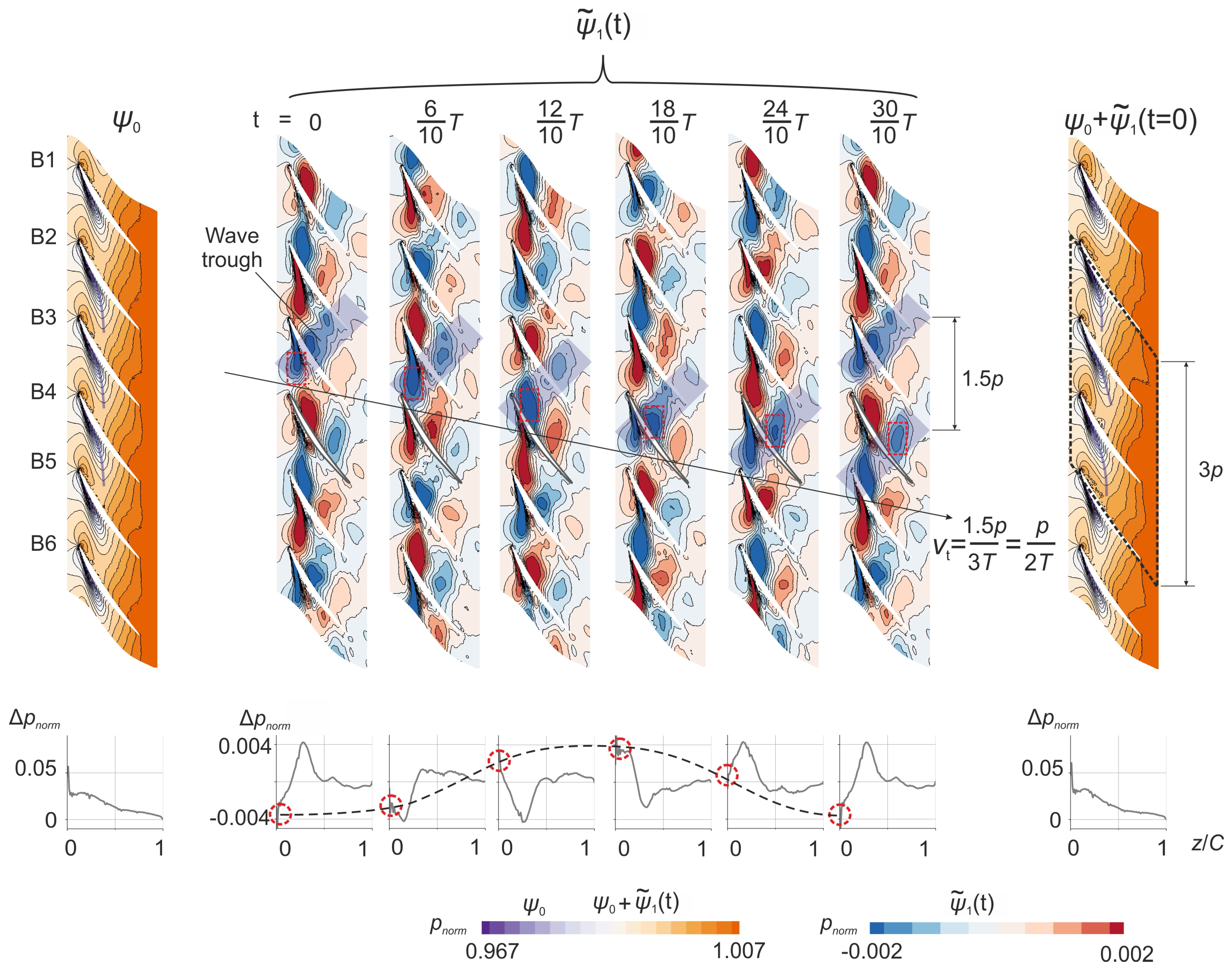
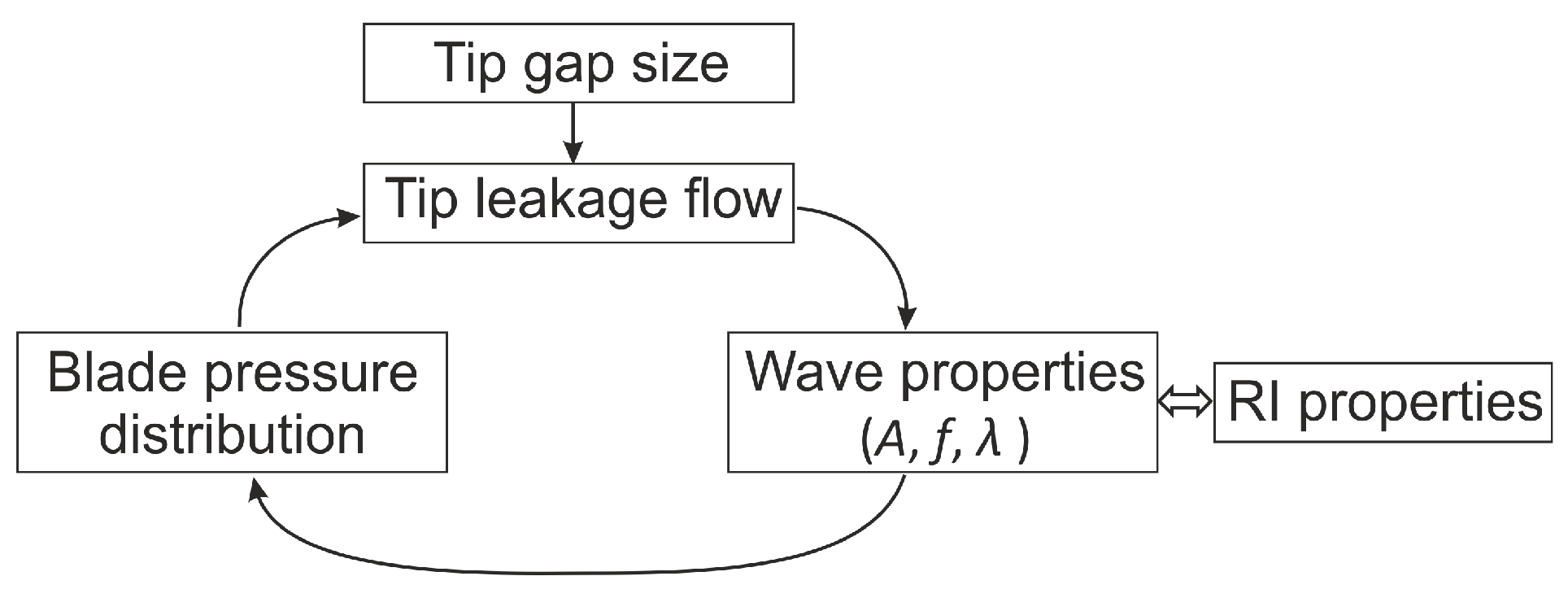
| Characteristic | Value |
|---|---|
| Rotating speed | 1000 rpm |
| Casing diameter | 1500 mm |
| Hub-to-tip ratio | 0.84 |
| Rotor blade count | 63 |
| Rotor blade chord length (Tip) | 116 mm |
| Solidity of rotor blades (Tip) | 1.55 |
| Mass flow at design point | 27.89 kg/s |
| Reynolds number at rotor inlet (Mid-span, design point) | |
| Mach number at rotor inlet (Mid-span) | 0.24 |
| Configuration | s (mm) | (%) |
|---|---|---|
| Small | 1.5 | 1.3 |
| Middle | 3.0 | 2.6 |
| Large | 5.0 | 4.3 |
| Case | Number of Meshed Passages | Total Grid Number (Million) |
|---|---|---|
| PSG1 | 1 | 2.39 |
| PSG3 | 3 | 7.17 |
| PSG6 | 6 | 14.34 |
Publisher’s Note: MDPI stays neutral with regard to jurisdictional claims in published maps and institutional affiliations. |
© 2021 by the authors. Licensee MDPI, Basel, Switzerland. This article is an open access article distributed under the terms and conditions of the Creative Commons Attribution (CC BY) license (https://creativecommons.org/licenses/by/4.0/).
Share and Cite
Chen, X.; Koppe, B.; Lange, M.; Chu, W.; Mailach, R. Rotating Instabilities in a Low-Speed Single Compressor Rotor Row with Varying Blade Tip Clearance. Energies 2021, 14, 8369. https://doi.org/10.3390/en14248369
Chen X, Koppe B, Lange M, Chu W, Mailach R. Rotating Instabilities in a Low-Speed Single Compressor Rotor Row with Varying Blade Tip Clearance. Energies. 2021; 14(24):8369. https://doi.org/10.3390/en14248369
Chicago/Turabian StyleChen, Xiangyi, Björn Koppe, Martin Lange, Wuli Chu, and Ronald Mailach. 2021. "Rotating Instabilities in a Low-Speed Single Compressor Rotor Row with Varying Blade Tip Clearance" Energies 14, no. 24: 8369. https://doi.org/10.3390/en14248369
APA StyleChen, X., Koppe, B., Lange, M., Chu, W., & Mailach, R. (2021). Rotating Instabilities in a Low-Speed Single Compressor Rotor Row with Varying Blade Tip Clearance. Energies, 14(24), 8369. https://doi.org/10.3390/en14248369





